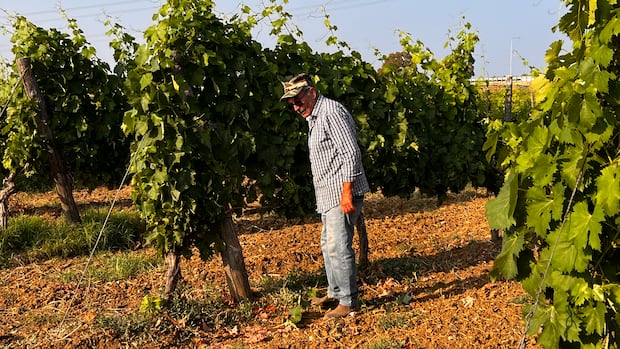Massimo Tosoni strolls among his vineyards, where rows extend like emerald ribbons under an unforgiving sun. In the backdrop lies the town of Tarquinia, perched on a hill once dominated by the ancient Etruscans.
Gesturing towards the rows of vineyards, he points out the local red grape, Ciliegiolo, renowned for its cherry-like scent. Tosoni laments the parched and hardened earth, a consequence of prolonged lack of irrigation that has drained the soil of its vitality.
Italy’s vineyards, much like those around the globe, are contending with increasingly hot and prolonged summers, unpredictable weather patterns, and diminishing water resources. These changes are compelling winemakers to reassess a fundamental aspect of their craft: terroir – the intricate harmony of soil, sunlight, wind, rain, and human intervention that imparts each wine with its distinct flavor, or some might argue, its essence.
Studies indicate that if global temperatures surge by over 2 degrees Celsius by the end of the century, up to 90 percent of Italy’s low-lying and coastal wine regions – about a third of the nation’s wine-producing areas – could become unsuitable for viticulture, mirroring the risks faced by most vineyards worldwide.
Italy, a prominent player in the global wine market with an industry valued at $20.7 billion Canadian dollars, equivalent to 10 percent of the country’s agri-food economy, witnessed record exports of $12 billion Canadian dollars in 2024 prior to U.S. President Donald Trump’s tariffs on the European Union. This growth was driven by premium and certified wines, despite producers grappling with extreme climate conditions such as drought in the south and hailstorms and heavy rainfall in the north.
In the northern Lazio region near Rome, which contributes approximately three percent of Italy’s wine output, Massimo Tosoni and his daughter, Martina Tosoni, 42, who returned to the family farm after a stint in the tourism sector in Spain, are among the numerous producers adapting to the changing climate.
Their white grape varieties, including Trebbiano, Malvasia, Vermentino, and Vioner, historically harvested in October, now mature by late August. Massimo recounted losing a third of their harvest last year due to climate change-induced delays in harvesting.
Nearby growers have begun substituting the traditional Sangiovese and Montepulciano red grapes with the more heat-tolerant Syrah, previously predominant in the warm southern island of Sicily. Martina emphasized that the scarcity of water, rather than heat, poses the most significant threat. Producers like her have embraced irrigation rotations and upgraded systems to enhance efficiency and minimize wastage, with younger growers leveraging technology for monitoring and accessing government support for addressing climate-related challenges.
While some producers explore vitivoltaic solar panels and reintroduce forgotten grape varieties better suited to a warmer climate, others advocate for strategic measures within vineyards, such as deploying shade cloths, adjusting trellising techniques to provide more shade to the fruit, and replanting rows to reduce direct sun exposure.
Lamberto Frescobaldi, a scion of a wine-producing family with a seven-century legacy, views the climate upheaval as an opportunity for intelligent adaptation. Water scarcity emerges as a critical concern in Tuscany, prompting a shift towards planting vineyards facing north and selecting rootstocks that delve deeper to access soil moisture efficiently. Invested in machines that circulate warm air to avert frost damage, the Frescobaldis are also diversifying their grape varieties to include heat-resilient Vermentino and other suitable options.
While these adjustments challenge centuries-old traditions and strain Italy’s Controlled and Guaranteed Designation of Origin framework aimed at preserving regional wine identities, Kimberly Nicholas, a sustainability scientist at Lund University, underscores the inevitable evolution in wine styles and traditions. The changing climate is already reshaping the essence of wines, prompting reflection on the disappearance of unique flavors and traditions.
In this era of climate uncertainty, the wine industry faces a pivotal juncture, with adaptation and innovation emerging as imperative strategies to safeguard the future of viticulture amidst a changing climate landscape.



